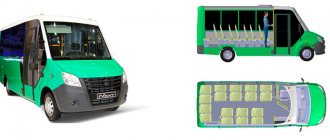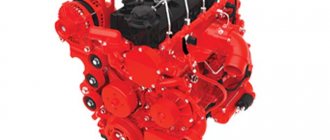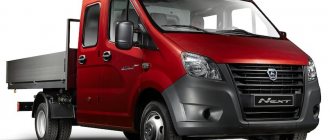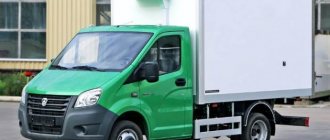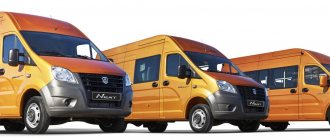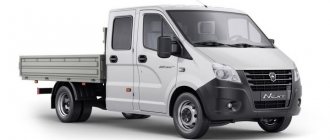Sergey Ukhov Photos by the author and
Who would have thought ten years ago that Russian manufacturers of conversions based on all-metal vans would begin to build buses of the original design, called “frame” buses. They are larger in capacity than "vanbuses" (minibuses made from all-metal vans), but are comparable in operating costs.
In recent years, these bus-minibus hybrids have gained an increasing number of supporters. Using the aggregate base of a light/medium commercial vehicle, a full-fledged bus body is built on its chassis, which itself is not load-bearing, but has a steel frame of sufficient strength. Hence the name “frame bus”. The most widespread example of this is the 19-seater GAZelle Next.
New minibus GAZelle Next
Convenience of boarding and disembarking passengers is ensured by a high doorway and an automated electric running board.
There are convenient handrails along the entire perimeter of the cabin for easy movement around the cabin, as well as for transporting standing passengers. The spacious interior with panoramic glazing allows passengers to move comfortably on the road.
The safety level of GAZelle NEXT has increased significantly. The body has increased rigidity and programmable deformation zones. In addition, the seats are equipped with 2-point inertial seat belts.
Constructive review
The process of preparing a bus for production can be called not even an adaptation of the “framework” to our conditions, but a redesign of its main systems for efficient operation in Russia. For example, the passive type convector interior heating system on the Serbian prototype, with a Webasto 16 kW additional heater, which is also noisy and increases fuel consumption, turned out to be ineffective. During winter operation, with constant opening and closing of doors, the system did not have time to warm up the cabin to the 18 °C required by technical regulations, and passengers experienced constant discomfort.
It was replaced with an engine-independent heating system, including an Eberspeher reheater (12 kW), plus two Zenit active liquid heaters (8 kW each) installed at the beginning and end of the cabin, and two 2 kW active liquid heaters installed in the opening of the first steps of each of the entrance doors. The latter create a thermal curtain at the entrance to the cabin and prevent icing of the bottom step.
Another identified drawback is the large mass of the entrance doors, which, under conditions of regular route operation, led to play and subsequent failure of the opening mechanisms. Leaving the door opening scheme (lean-sliding type) unchanged, in Russia they found a lighter and more reliable analogue - instead of double-glazed windows, they used electrically heated glass, which significantly reduced the weight of the doors, while fulfilling all the necessary requirements of technical regulations.
When carrying out work on thermal, noise and vibration insulation of the interior, materials that were innovative for domestic bus manufacturers were used. So-called “cold bridges” are excluded. Highly efficient LED lampshades were used with the ability to switch lighting modes to standby and main light (requirement of technical regulations). The company has completely designed and implemented a new electrical system with original bus system control units, which allow the installation of a variety of additional equipment without significant changes, starting with individual climate control units, light, multimedia and ending with a variety of equipment for specialized vehicles (laboratories, medical, operational, headquarters cars).
Thus, the original design of the Serbian frame bus has undergone changes in three directions at once. The first is the adaptation of systems, components and assemblies of a passenger car for operation in harsh Russian conditions. The second is the use of more modern and efficient systems and units (namely heating and electrical equipment), which reduce operating costs. The third is the creation of a universal frame body, in which any vehicle can be made at the customer’s request (city, tourist or school bus, auto laboratory, car for special services and much more). The versatility of the bus is also supported by the high proportion of Russian-made components used in the “framework”, which gives the vehicle the right to participate in state and municipal competitions and tenders.
It remains to add that at the moment the company is ready to produce up to 5 Nizhegorodets VSN frame buses in completely different configurations every month and increase production volumes in accordance with existing demand.
Advantages of the new GAZelle NEXT
- load capacity up to 2.6 tons
- volume of transported cargo up to 22 m³
- fuel consumption from 8.5 l/100 km
- warranty 3 years or 150 thousand km
- Maintenance interval - 20,000 km
- spare parts are 3-5 times cheaper compared to foreign analogues
- cost of ownership per 1 kilometer run - 7.2 rubles
- anti-corrosion guarantee - 8 years
The cost of the car is 30–40% lower than the cost of European analogues. The payback period is 25 months, which is almost 1.6 times less than that of European analogues.
Modern technical solutions, components from the world's leading manufacturers, special attention to every detail, strict quality control are the distinctive features of Next, thanks to which this car works flawlessly.
The external parts of the Next cabin are completely galvanized and treated with modern anti-corrosion materials. The car has plastic fenders. All joints and seams are protected with anti-corrosion coating and special sealants.
The new GAZelle-Next uses components from famous world manufacturers
- BOSCH - vacuum booster, ABS, wiper gear motor
- MANDO — gas-filled shock absorbers, front brakes
- WEBASTO - pre-heater
- DELPHI - climate control system with air conditioning
- ZF - rack and pinion steering with hydraulic power steering
- TAKATA - seat belts for driver and passengers
GAZelle-NEXT is equipped with one of 4 types of engines:
Diesel Cummins ISF 2.8 is a development of an American company. Engine power - 149 hp. Working volume - 2.8 l. Maximum torque - 330 N.m. Estimated service life - 500,000 km.
The gasoline Evotech 2.7 is a joint development of the GAZ Group and Tenergy (a leading company in the development of power units from South Korea). Four-cylinder, in-line, four-stroke, gasoline engine with an integrated microprocessor-based fuel injection and ignition control system. Working volume 2.69 l. Power - 78.5 kW, 106.8 hp. Estimated service life - 400,000 km.
Bi-fuel LPG (propane) 4-stroke, injection. Number of cylinders 4, in-line arrangement. Working volume 2.69 l. Maximum power, kW (hp) when running on gasoline - 78.5 (106.8), when running on gas - 76.7 (104.3)
Bi-fuel CNG (methane). 4-stroke engine with 120 hp power. with turbocharging, intermediate cooling of charge air and an integrated microprocessor control system for fuel supply and ignition. Cruising range on two types of fuel is up to 800 km. Compliance with Euro-4 standards
Video of the new GAZelle Next
Catch up
Compared to a conventional minibus on the same chassis, the volume of which is strictly limited by an all-metal body, the frame body is larger in capacity and can be made in various design and dimensional options. In fact, it is a complex superstructure on a chassis and differs from ordinary vans or “shift vehicles” in that it is rigidly connected to the engine compartment and, in addition to the passenger compartment, also includes a driver’s cabin.
The advantage of a “framework” over an all-metal analogue on the same chassis is obvious: greater capacity and variability of the body at absolutely the same operating costs. But there are also “disadvantages”: the cost of manufacturing a “framework” is higher than a stamped body. Accordingly, the price is higher.
This price may even exceed the cost of a small or medium class full-fledged carriage bus of similar capacity, but the “framework” will be much cheaper to operate. This is like the difference in the costs of maintaining and servicing a light-duty truck and a full-fledged truck.
This is why “frameworks” are so popular in Europe. In Ukraine, the production of frame buses on the chassis of the popular first-generation Nizhny Novgorod semi-truck "GAZelle" began ten years earlier than the Gorky Automobile Plant mastered the production of a frame bus based on the second-generation semi-truck "GAZelle Next".
Having realized all the advantages of the described design, Russian passenger carriers also need larger frame buses, such as the new product - the Nizhegorodets small class bus VSN-700.
It is profitable to buy a GAZelle Next minibus
Already in the basic configuration, the GAZelle is equipped with ABS, power steering, halogen optics, an on-board computer, cruise control, a horizontal ceiling handrail, a pre-heater, a tilt-adjustable steering column, heated side mirrors, a central lock and two fire extinguishers.
To order, we will equip the GAZelle NEXT with an audio system with a touch screen, a video monitoring system for the interior, a tachograph, the ERA Glonass system, a heated driver's seat and much more.
Call us or send a message and become the happy owner of a new GAZelle NEXT minibus on favorable terms.
Pre-production
The identified shortcomings turned out to be non-critical, and work on preparing the production of our own “framework” began. In 2014, ST Nizhegorodets acquired licensed drawings and equipment for assembling the vehicle, purchased the appropriate equipment, carried out all the necessary tests, received the Russian OTTS and in the fall began production of the first own samples of a frame bus.
The resulting bus from the Nizhny Novgorod creators looks harmonious. The hood layout adds speed to the long body (more than 7.5 m), and the familiar “face” from IVECO Daily will not create problems with brand identification. At the time of this writing, ST Nizhny Novgorod has already received the first third-generation IVECO Daily cars with a cosmic front end design, which will soon appear on the “framework” as well.
Despite the external similarity with the Italian chassis donor, only the hood cover, headlights, false radiator grille and the front part of the bumper remained from the original. The rest of the front and body parts are original and were created specifically for the frame bus. The vast majority of body panels are plastic, which reduces the weight of the body compared to a steel counterpart, and also eliminates the possibility of corrosion. Plastic panels are attached to a steel frame, which is welded here, in the depths. Even the glass supplier is a Russian company, not to mention the doors, seats, interior trim elements, handrails, shelves and other components. As a result, only the chassis (frame, power unit, chassis), heaters and an optional interior multimedia system and climate control systems come from abroad for the new Russian “framework”. Although these components, at the request of the customer, can be replaced with domestic ones.
Advantages of sandwich panels
Frameless manufacturing technology is more relevant and progressive. Vans made from sandwich panels have better thermal insulation characteristics and lighter weight. When producing a body without a frame, voids between the panels are eliminated, which can become “thermal bridges”.
Isothermal panels are a one-piece structure that consists of outer, inner layers and insulation. Sandwich panels can be three- or five-layer.
When docking, cushioning material and industrial glue are used, which eliminates heat loss and provides high strength to the van. This body retains temperature well, and its qualities do not deteriorate throughout the entire period of operation. If the connections are made with high quality, the frameless structure lasts longer than the frame one.
Also, the advantages of frameless technology include:
- Various thickness options for the panels themselves (from 60 to 100 mm).
- There is no need for additional painting and interior decorative trim, because clad metal is used.
- The use of multilayer double-glazed windows can further reduce heat loss.
- No corrosion.
Research
Thermal imaging studies are the only way to check a van for heat loss due to design defects.
An analysis of shift buses at an air temperature of –250 C showed that a body made using frameless technology performs better.
All vans were on equal terms. The shift cabins were heated as much as possible using a heating system. Then, using a special device, a thermal imager, heat loss measurements were taken and “cold bridges” were identified. Heat leaks were checked not only on the walls, but also on the roof (namely, on the ventilation hatches).
In the frame interior, heat losses were detected in areas of the frame itself, as well as through windows and escape hatches. The heat loss of a van made of sandwich panels turned out to be almost zero.

